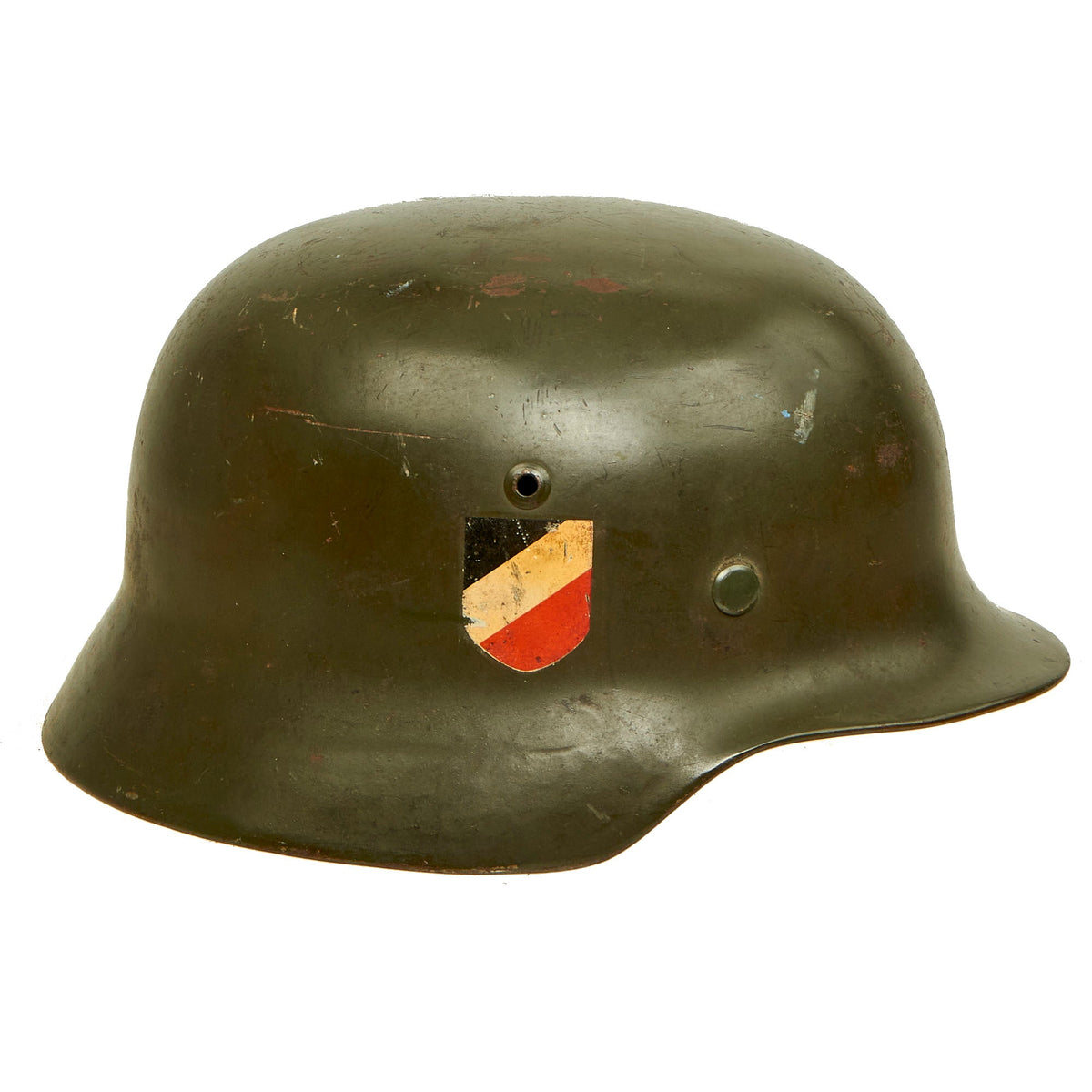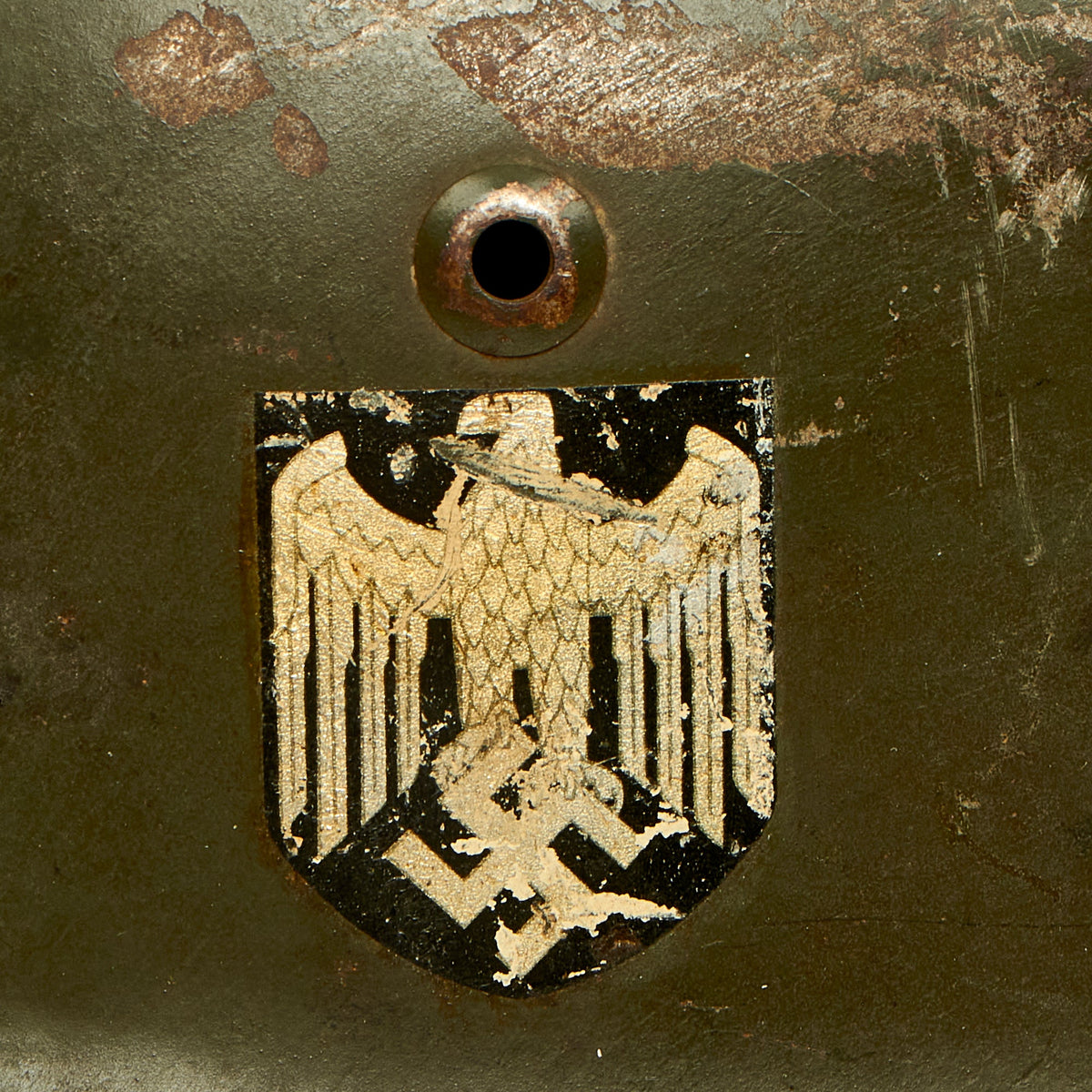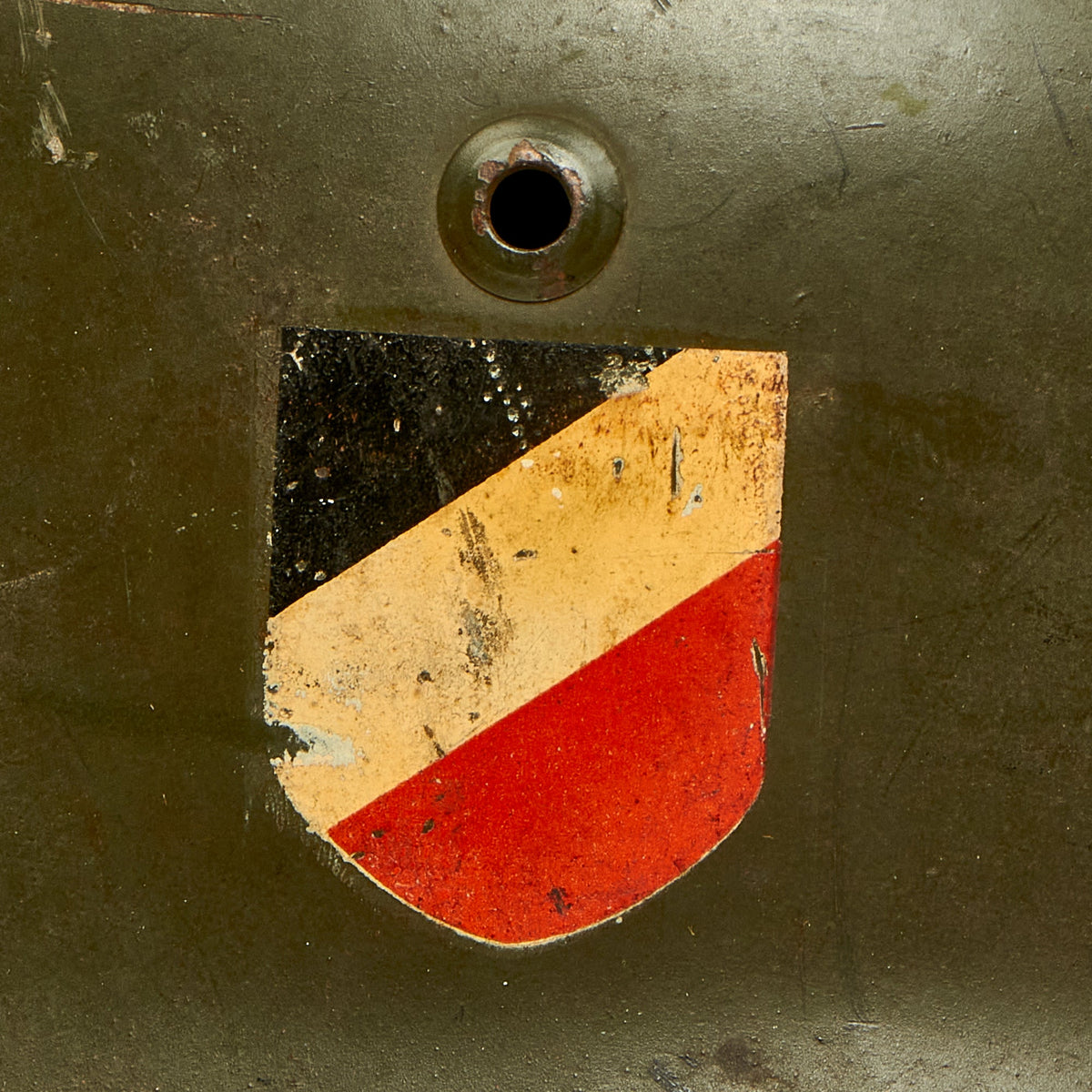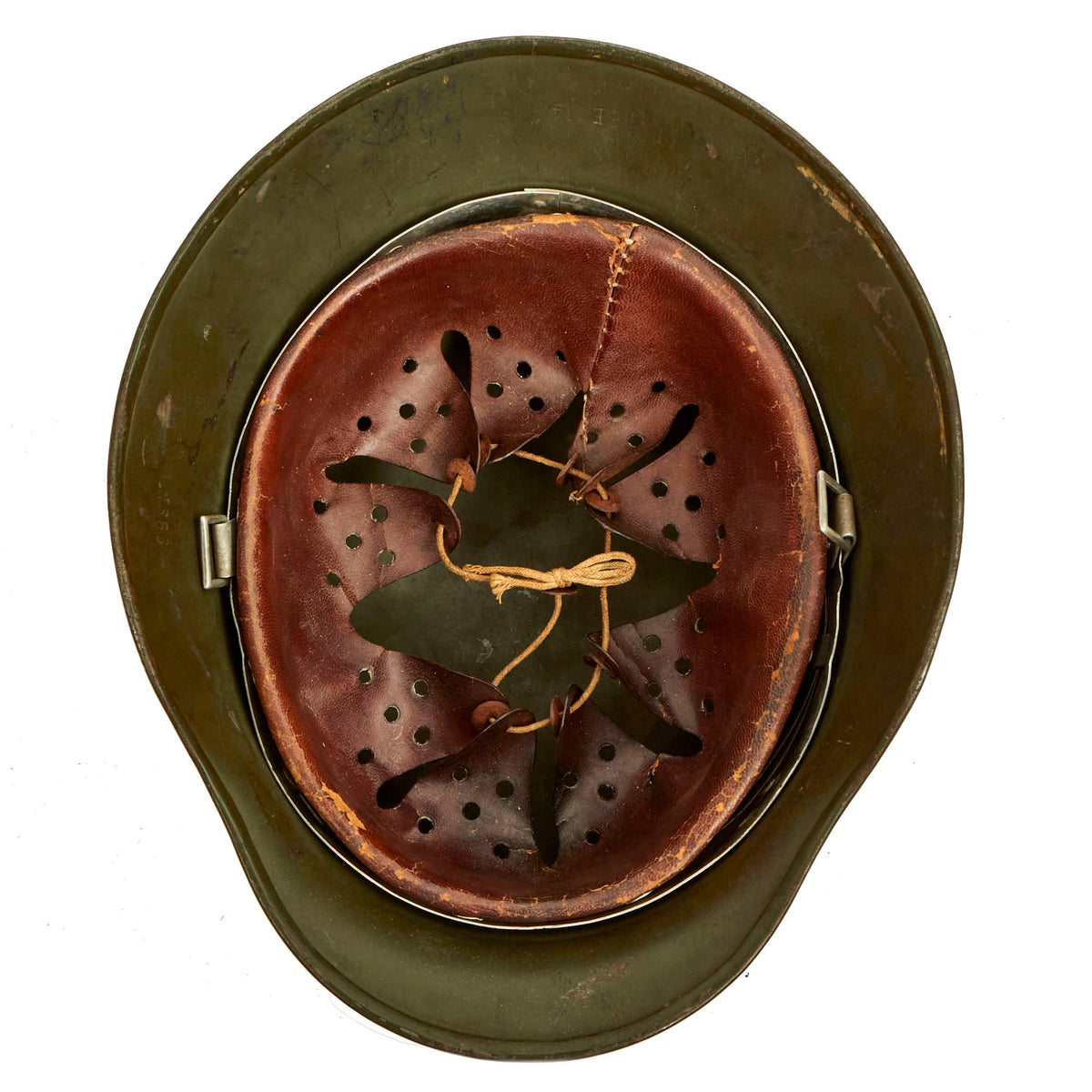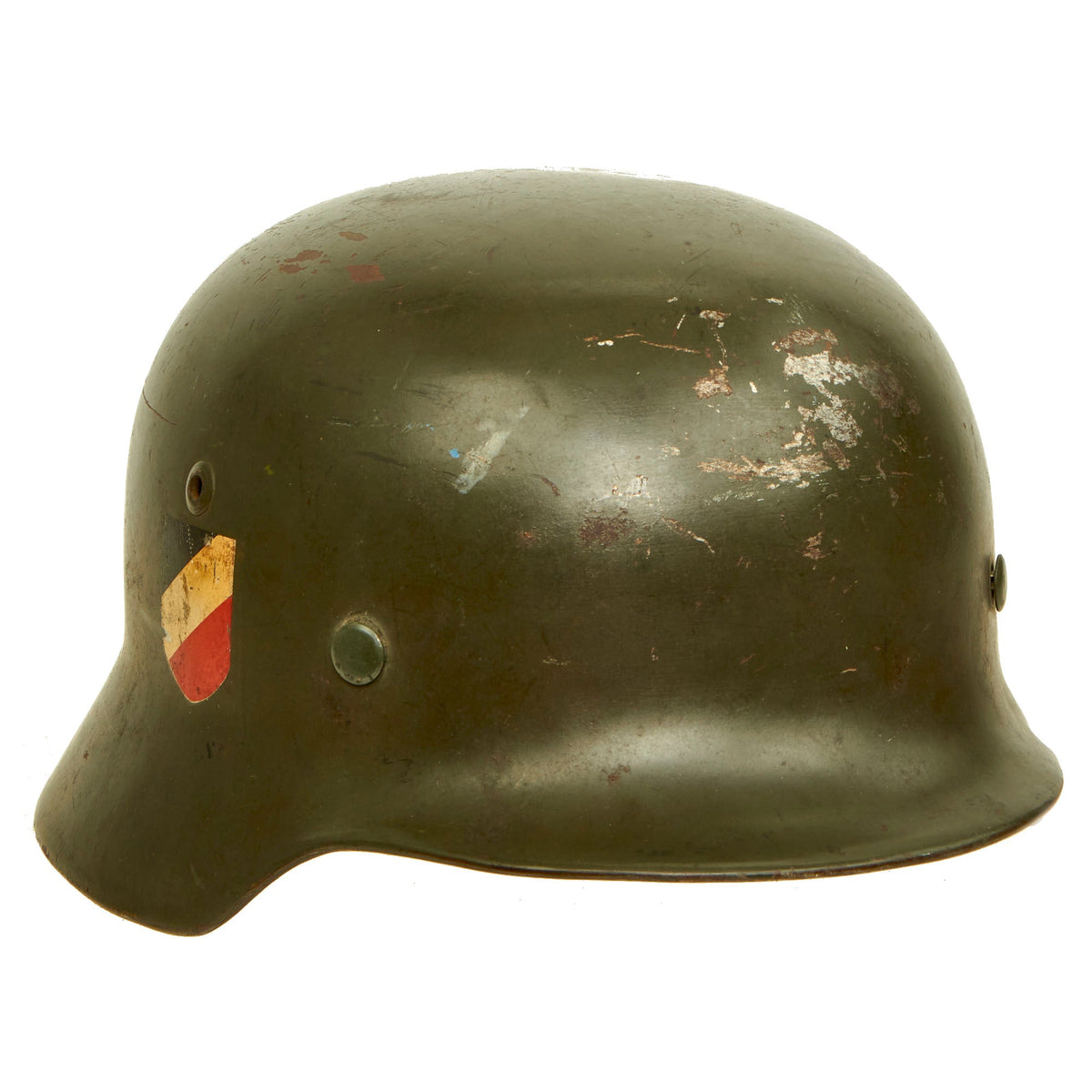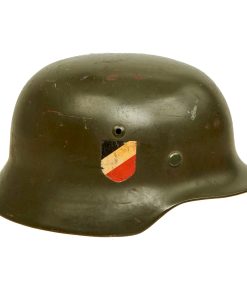Original German WWII Extra Large Army Heer M35 Double Decal Helmet with 1937 Dated 60cm Liner – NS68 Original Items
$ 2.995,00 $ 748,75
Original Item: Only One Available. This is an incredible near excellent condition all original example of a German WWII M35 helmet, as issued to the Heer (Army), with very desirable “Double Decals”. This stamped sheet steel construction helmet retains almost all of its original Pre-WWII lighter smooth Apfel-grün (apple green) paint job, showing some wear around the brown area, with very little oxidation or other major damage. Early helmets such as this almost always have very worn paint, and often get repainted using the later Panzergrau (armored gray) paint used later in the war. It’s extremely rare to find a helmet with original Apple Green paint in such great condition!
The use of the second decal was discontinued in 1940, and in 1943 it was ordered that helmets with the national colors have them removed. The decals on this helmet however escaped that fate, so it still has both decals, a real treat! The left side of the helmet features a Heer eagle decal, which is retained about 85%, still bright and reflective, with some scratching and chipping from service. The right side of the helmet features a national colors decal, which is also retained about 90%, showing just a bit of wear. Both have yellowed a bit due to degradation of the lacquer top coat, giving them a fantastic aged look.
The reverse, interior, neck guard apron is serial number stamped, E114 and the interior, left side, apron has a stamped manufacturer’s code and size, NS68 indicating that Vereinigte Deutsche Nikelwerke, of Schwerte, Germany manufactured it in size 68. Size 68 is a rare extra large size that can accommodate liners from 60cm to 61cm or US 7 1/2 to 7 5/8. Size 68 shells are the hardest to find and are therefore the most valuable to a collector.
All three liner retaining pins are intact, and all still retain the original apple green very well, with just a bit of wear. The interior of the helmet still has the original M31 leather liner with all NINE of its fingers intact, only seen on extra large liners such as this, with an intact original top tie. The leather is still relatively soft, has has matured to a lovely russet brown color, showing some wear and tearing around the edges, which is very common. The leather washers on the back that reinforce the holes in the fingers have also mostly become detached. The liner band is aluminum, with square aluminum chin strap loops attached without any side reinforcements, which explains why the band is bent somewhat around the loops. Later Pre-war examples would have a double layer of aluminum on the side to prevent bending. The left exterior of the liner band is marked 68 n.A / 60, indicating that it is a size 60 liner for a size 68 shell. The right side displays the full manufacture information, as well as a date:
B. & C.
BERLIN
1937
This liner was made by Biedermann & Czarnikow, a German company who later moved operations to Łódź in occupied Poland to take advantage of the slave labor in the ghetto located there. NSDAP authorities renamed Łódź to Litzmannstadt in honor of the German General Karl Litzmann who had captured the city in the previous World War. This is exactly the right period and type of liner for this very early helmet. It unfortunately does not have the original chinstrap anymore.
Overall a fantastic 100% genuine M35 Double Decal Heer Army helmet in great condition! It looks great, and all components are correct, showing no updating from when it was issued! This is an item that will only continue to appreciate in value over time!
The first “modern” steel helmets were introduced by the French army in early 1915 and were shortly followed by the British army later that year. With plans on the drawing board, experimental helmets in the field, (“Gaede” helmet), and some captured French and British helmets the German army began tests for their own steel helmet at the Kummersdorf Proving Grounds in November, and in the field in December 1915. An acceptable pattern was developed and approved and production began at Eisen-und Hüttenwerke, AG Thale/Harz, (Iron and Foundry Works), in the spring of 1916.
These first modern M16 helmets evolved into the M18 helmets by the end of WWI. The M16 and M18 helmets remained in usage through-out the Weimar Reichswehr, (National Defence Force, Circa 1919-1933), era and on into the early years of the Third Reich until the development of the smaller, lighter M35 style helmet in June 1935.
In 1934 tests began on an improved Stahlhelm, whose design was a development of World War I models. The Eisenhüttenwerke company of Thale carried out prototype design and testing, with Dr. Friedrich Schwerd once again taking a hand.
The new helmet was pressed from sheets of molybdenum steel in several stages. The size of the flared visor and skirt was reduced, and the large projecting lugs for the obsolete armor shield were eliminated. The ventilator holes were retained, but were set in smaller hollow rivets mounted to the helmet’s shell. The edges of the shell were rolled over, creating a smooth edge along the helmet. Finally, a completely new leather suspension, or liner, was incorporated that greatly improved the helmet’s safety, adjustability, and comfort for each wearer. These improvements made the new M1935 helmet lighter, more compact, and more comfortable to wear than the previous designs.
The Army’s Supreme Command officially accepted the new helmet on June 25, 1935 and it was intended to replace all other helmets in service.
More than 1 million M1935 helmets were manufactured in the first two years after its introduction, and millions more were produced until 1940 when the basic design and production methods were changed.
Fast Shipping with Professional Packaging
Thanks to our longstanding association with UPS FedEx DHL, and other major international carriers, we are able to provide a range of shipping options. Our warehouse staff is expertly trained and will wrap your products according to our exact and precise specifications. Prior to shipping, your goods will be thoroughly examined and securely secured. We ship to thousands clients each day across multiple countries. This shows how we're dedicated to be the largest retailer on the internet. Warehouses and distribution centres can be located throughout Europe as well as the USA.
Note: Orders with more than one item will be assigned a processing date depending on the item.
Before shipping before shipping, we'll conduct a thorough inspection of the items you have ordered. Today, the majority of orders will be delivered within 48 hours. The delivery time will be between 3-7 days.
Returns
The stock is dynamic and we cannot completely manage it because multiple stakeholders are involved, including our factory and warehouse. So the actual stock may alter at any time. It's possible that you may not receive your order once the order has been made.
Our policy is valid for a period of 30 days. If you don't receive the product within 30 days, we are not able to issue a refund or an exchange.
You can only return an item if it is unused and in the same state as the day you received it. You must have the item in its original packaging.
Related products
Uncategorized
Uncategorized
Uncategorized
Uncategorized
Uncategorized
Uncategorized
Uncategorized
Armored Burgonet Helmet & Polearm from Scottish Castle Leith Hall Circa 1700 Original Items
Uncategorized
Uncategorized
Uncategorized
Uncategorized
Angolan Rebel 1970s era 60mm Inert Display Mortar from Angolan Civil War Original Items
Uncategorized
Armoured Fighting Vehicles of the World: AFVs of World War One (Hardcover Book) New Made Items
Uncategorized
Band of Brothers ORIGINAL GERMAN WWII Le. F.H. 18 10.5cm ARTILLERY PIECE Original Items
Uncategorized
Uncategorized
Uncategorized
Uncategorized
Uncategorized
Uncategorized
Uncategorized
Uncategorized
